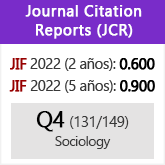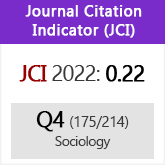Una perspectiva socio-ecológica sobre el acoso escolar. Una nueva síntesis
DOI:
https://doi.org/10.3989/ris.2008.11.22Palabras clave:
acoso escolar individual, acoso escolar grupal, clima escolar, Distrito municipal, socializaciónResumen
En los últimos años han proliferado los estudios sobre el acoso escolar, destacando la prevalencia o las características de éste. sin embargo, se ha avanzado poco en la explicación de la etiología del fenómeno en sí. Utilizando variables ecológicas externas que influyen a priori en las posibles conductas violentas en el colegio, se aplica la técnica discriminante en una muestra de jóvenes que cursan algún nivel de estudios de secundaria obligatoria. los resultados muestran a la clase social/ estatus socioeconómico como una robusta variable independiente capaz de clasificar en mayor medida que las demás al grupo de los violentos tanto individuales como colectivos frente a los no violentos en el ámbito escolar. este hallazgo incorpora evidencia empírica sobre la importancia de lo que Wilson denominó como “presión del vecindario” o lo que Sampson acuñó como “eficacia colectiva”.
Descargas
Citas
Ahmed, E. and V. Braithwaite 2004. “Bullying and victimization: cause for concern for both families and schools”, Social Psychology of Education 7: 35-54. doi:10.1023/B:SPOE.0000010668.43236.60
Anderson, C. and K. Dill. 2000. “Video games and aggressive thoughts, feeling and behaviour in the laboratory and in life”, Journal of Personality and Social Psychology 78: 772-790. doi:10.1037/0022-3514.78.4.772
Aisenberg, E. and T. Herrenkohl. 2008. “Community violence in context”, Journal of Interpersonal Violence 23: 296-315. doi:10.1177/0886260507312287
Akiba, M. et al. 2002. “Student victimization and school system effects on school violence in 37 nations”, American Educational Research 39: 829-853. doi:10.3102/00028312039004829
Baldry, A. and D. Farrington. 2005. “Protective factors as moderators of risk factors in adolescence bullying”, Social Psychology of Education 8: 263-284. doi:10.1007/s11218-005-5866-5
Benbenishty, R. and R. Astor. 2005. School violence in context. Oxford: Oxford University Press. doi:10.1093/acprof:oso/9780195157802.001.0001
Bosma, H., et al. 2001. “Neighbourhood socioeconomic status and all-cause mortality”. American Journal of Epidemiology 153: 363- 371. doi:10.1093/aje/153.4.363
Burchfield, K. and W. Mingus. 2008. “Not in my neighbourhood”. Criminal Justice and Behavior 35: 356-374. doi:10.1177/0093854807311375
Caughy, M.O. et al. 2006. “Neighbourhood matters: racial socialization of African American children”. Child Development 77: 1220-1236. doi:10.1111/j.1467-8624.2006.00930.x
Comstock, G. and E. Scarrer. 2003. “Meta-analyzing the controversy over television violence and aggression”. In D. Gentile (coord.). Media violence and children. London: Praeger: 205-226.
Conger, R. D. et al. 2000. The role of economic pressure in the lives of parents and their adolescents: the family stress models. In L. Crockett and P. Silbereisen (coord.). Negotiating adolescence in times of social change. Cambridge: Cambridge University Press,: 201-223.
Conger, R.D. and K.J. Conger. 2002. “Resilience in Midwestern families: selected finding from the first decade of a prospective”, longitudinal study. Journal of Marriage and Family 64: 361-373. doi:10.1111/j.1741-3737.2002.00361.x
Connell, R.W. 1995. Masculinities. Berkeley: University of California Press.
Crosnoe, R. and G. Elder. 2004. “Family dynamics, supportive relations and educational resilience during adolescence”. Journal of Family Issues 25: 571-602. doi:10.1177/0192513X03258307
Crosnoe, R. and J. Trinitapoli. 2008. “Shared family activities and the transition from childhood into adolescence”. Journal of Research on Adolescence 18: 23-48 doi:10.1111/j.1532-7795.2008.00549.x
Chaix, et al. 2008. “Neighbourhood social interactions and risk of acute myocardial infarction”. Journal of Epidemiology and Community Health 62: 62-68. doi:10.1136/jech.2006.056960
Davis, et al. 2008. “Getting the complete picture: combining parental and child data to identify the barriers to social inclusion for children living in low socio- economic areas”. Child Care, Health and Development 34: 214-222. doi:10.1111/j.1365-2214.2007.00786.x
Dempsey j., G. fireman and W. eugene. 2006. “Transitioning out of peer victimization in school children: gender and behavioral UK) behavioral USA) characteristics”. Journal of Psychopathology and Behavioral Assessment 26: 273- 282.
Dowsett, cH., A. Huston and A. Imes. 2008. “Structural and process features in three types of child care for children from high and low income families”. Early Childhood Research Quarterly 23: 69-93.
Eslea, m. et al. 2003. “Friendship and loneliness among bullies and victims: data from seven countries”. Aggressive Behavior 30: 71-83.
Glover, D. et al. 2000. “Bullying in secondary schools: incidence, impact and intervention”. Educational Research 42: 141-156. doi:10.1080/001318800363782
Hagestad, G. and V. call. 2007. “Pathways to childlessness”. Journal of Family Issues 28: 1338-1361. doi:10.1177/0192513X07303836
Hawskins, D. et al. 2007. “Non resident father involvement and adolescent well-being: father effects or child effects”. American Sociological Review 72: 990-1010.
Holt, M. and D. Espelage. 2007. “Perceived social support among bullies, victims and bully-victims”. Journal of Youth and Adolescence 36: 984-994. doi:10.1007/s10964-006-9153-3
Huesmann, L.R. et al. 2003. “Longitudinal relations between children’s exposure to TV violence and their aggressive and violent behaviour in young adulthood”. Development Psychology 39: 201-221. doi:10.1037/0012-1649.39.2.201
Kellner, D. 1995. Media culture. London: Routledge.
Kenway, J. and L. Fitzclarence. 1997. “Masculinity, violence and schooling: challenging poisonous pedagogies”. Gender and Education 9: 117-133. doi:10.1080/09540259721493
Klecka, W. 1990. Discriminant analysis. Newbury Park.
Kuntsche, E. 2004. “Hostility among adolescents in Switzerland”. Journal of Adolescent Health 34: 230-236. doi:10.1016/S1054-139X(03)00266-0
Kuntsche, E. 2006. “Television viewing and forms of bulling among adolescents from eight countries”. Journal of Adolescent Health 39: 908-915. doi:10.1016/j.jadohealth.2006.06.007
Kyvdgaard, B. 2003. The criminal career. Cambridge: Cambridge University Press.
Loeber, r. and M. Stouthamer-Loeber. 1998. “Development of juvenile aggression and violence: some common misconceptions and controversies”. American Psychologist 53: 242-259.
Maccoby, E. 1999. The Two Sexes: Growing Up Apart; Coming Together, Cambridge: Harvard University Press.
Moffit, T. et al. 2001. Sex differences in antisocial behaviour. Cambridge: Cambridge University Press.
Murray, S. et al. 2008. “School adjustement in the earley grades: toward an integrated model of neighbourhood, parental, and child processes”. Review of Educational Research 78: 3-32. doi:10.3102/0034654307309917
Nettles, S.M. et al. 2008. “School adjustment in the early grades: toward an integrated model of neighbourhood, parental, and child processes”. Review of Educational Research 78: 3-32. doi:10.3102/0034654307309917
Nicholson, H. 2008. “Choose to hug, not hit”. Family Court Review 46: 11-36.
Noack, P. 2000. Adolescent peer relations in times of social change. In Crockett L. And Silbereisen (coord.). Negotiating adolescence in times of social change. Cambridge: Cambridge University Press.
Nofzinger, S. and D. Kurtz. 2005. “Violent lives: a lifestyle model linking exposure to violence to juvenile violent offending”. Journal of research in Crime and Delinquency 42: 3-26. doi:10.1177/0022427803262061
Olweus, D. 1993. Bullying at school, What we know and what we can do. Oxford: Blackwell.
Paik, H. and G. Comstock. 1994. “The effects of television violence on antisocial behaviour: a meta- analysis”. Communication Research 21: 516-546. doi:10.1177/009365094021004004
Pellegrini, A.D. et al. 1999. “School bullies victims, and aggressive victims: factors relating to group affiliation and victimization in early adolescence”. Journal of Educational Psychology 91: 216-224. doi:10.1037/0022-0663.91.2.216
Perry, D. G. et al. 1998. “Victims of peer aggression”. Developmental Psychology 24: 807-814. doi:10.1037/0012-1649.24.6.807
Peterson, J. S. and K.E. Ray. 2006. “Bullying Among the Gifted: The Subjective Experience”. Gifted Child Quarterly 50: 252-269. doi:10.1177/001698620605000305
Popenoe, D. 1996. Life without father. New York: The Free Press.
Rutter, m. and H. giller. 2000. La conducta antisocial de los jóvenes. Madrid: Cambridge University Press.
Sampson, R. J. and S.W. Raudenbush. 1999. “Systematic social observation of public spaces: a new look at disorder in urban neighbourhoods”. American Journal of Sociology 105: 603-651. doi:10.1086/210356
Sampson, et al. 2002. “Assessing neighbourhood effects: social processes and new directions in research”. Annual Review of Sociology 28: 433-478. doi:10.1146/annurev.soc.28.110601.141114
Sentse, M. et al. 2007. “Person-group dissimilarity in involvement in bullying and its relation with social status”. Journal Abnormal Child Psychology 35: 1009-1019. doi:10.1007/s10802-007-9150-3 PMid:17588201
Sharkey, P. 2006. “Navigating dangerous streets: the sources and consequences of street efficacy”. American Sociological Review 71: 826-846.
Sharkey, J. and S. Horel. 2008. “Neighborhood socioeconomic deprivation and minority composition are associated with better potential spatial access to the ground truthed food environment in a large rural area”. Journal of Nutrition 138: 620-627.
Shaw, D. S. et al. 1999. “A prospective study of the effects of marital status and family relations on young children’s adjustment among African, American families”.Child Development 70: 742-755. doi:10.1111/1467-8624.00053 PMid:10368919
Simon R.L. et al. 2005. “Collective efficacy, authoritative parenting and delinquency: a longitudinal test of a model integrating community an family level processes”. Criminology 43: 371-393.
Stein, a.h. and L.K. friedrich. 1975. “Impact of television on children and youth”. In E. M. Hetherington (coord.). Review of Child Development Research 5: 183-256.
Stephenson, p. and D. smith. 1992. “Why some schools don’t have bullies”. In M. Elliot (coord.) Bullying: a practical guide to coping for schools 133- 145. Essex: Longman.
Stevens, V. et al. 2002. “Relationship of the family environment to children’s involvement in bully/victim problems at school”. Journal of Youth and Adolescence 31: 419-428. doi:10.1023/A:1020207003027
Stewart, e. and R. Stewart. 2007. “The effect of neighbourhood context on the college aspirations of African American adolescents”. American Educational Research Journal 44: 896-919.
Verkuyten, M. and Thijs, J. 2002. “School satisfaction of elementary school children: the role of performance, peer relations, ethnicity and gender”, Social Indicators Research, 59: 203-228. doi:10.1023/A:1016279602893
Virtanem, et. alt. 2007. “Neighbourhood socioeconomic status, health and working conditions of school teachers”, Journal of Epidemiology and Community Health, 61: 326-330.
Wilson, J. ed.) 1993. The ghetto underclass, Newbury Park, Sage.
Williams, S.T. et al. 2007. “The development of interpersonal aggression during adolescence: the importance of parents, siblings, and family economics”, Child Development, 78 5): 1526-1542.
Witkowska, E. and A. Kjellberg. 2005. “Dimension of peer sexual harassment in Swedish high school: what factor structures show the best fit to girls and boys self-report”. Sex Roles 53: 677- 687. doi:10.1007/s11199-005-7733-4
Wolke, D. et al. 2001. “Bullying and victimization of primary school children in England and Germany”. British Journal of Psychology 92: 673-696. doi:10.1348/000712601162419 PMid:11762868
Zillmann, D. and J.B. Weaver. 1999. “Effects of prolonged exposure to gratuitous media violence on provoked and unprovoked hostile behaviour”. Journal of Applied Social Psychology 29: 145-165. doi:10.1111/j.1559-1816.1999.tb01379.x
Descargas
Publicado
Cómo citar
Número
Sección
Licencia
Derechos de autor 2009 Consejo Superior de Investigaciones Científicas (CSIC)

Esta obra está bajo una licencia internacional Creative Commons Atribución 4.0.
© CSIC. Los originales publicados en las ediciones impresa y electrónica de esta Revista son propiedad del Consejo Superior de Investigaciones Científicas, siendo necesario citar la procedencia en cualquier reproducción parcial o total.Salvo indicación contraria, todos los contenidos de la edición electrónica se distribuyen bajo una licencia de uso y distribución “Creative Commons Reconocimiento 4.0 Internacional ” (CC BY 4.0). Puede consultar desde aquí la versión informativa y el texto legal de la licencia. Esta circunstancia ha de hacerse constar expresamente de esta forma cuando sea necesario.
No se autoriza el depósito en repositorios, páginas web personales o similares de cualquier otra versión distinta a la publicada por el editor.

















